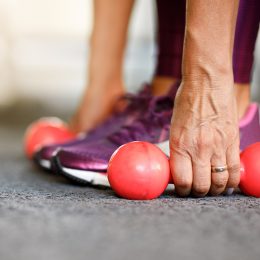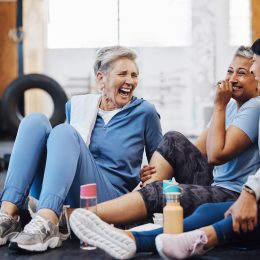Make Every Workout Better—with Your Mind
What happens when brain teasers meet biceps curls? Your total health improves.
 The older adults in Lynell Ross’s Balance and Breathing class look forward to the homework. At the end of each session, Ross hands out worksheets that include word scrambles, Sudoku puzzles, and word matching. At the next class, students compare answers as they stretch and do strength and balance exercises.
The older adults in Lynell Ross’s Balance and Breathing class look forward to the homework. At the end of each session, Ross hands out worksheets that include word scrambles, Sudoku puzzles, and word matching. At the next class, students compare answers as they stretch and do strength and balance exercises.
Often, Ross throws in modified yoga and tai chi moves to introduce new movement patterns—another mental test.
As a certified personal trainer in Auburn, California, who specializes in working with seniors and individuals with special needs, Ross loves to see the level of engagement and enthusiasm classes like this bring.
“Combining physical exercises with brain exercises has so many benefits,” she says. “As we age, we need to make an effort to create new neural pathways, and help the brain become more flexible and adaptive to change.”
The Brain–Body Connection
Exercise has often been linked to brain health, both in terms of mood and cognitive function. One study noted this is likely due to increased blood circulation to the brain and better efficiency with how the brain “fires” up its messaging.
The researchers added that this can have a ripple effect as well, with improvements in sleep, energy, stamina, stress relief, pain control, and other health benefits.
But the idea of deliberately adding a “thinking” element to a workout is only now building up steam. In 2019, the American Council on Exercise dubbed combined physical-cognitive training one of the “next big trends in fitness.”
As more older adults strive to dodge dementia and stay active and independent deep into the retirement years, fitness experts believe mind-body training can help them stay mentally sharp, not just physically strong.
Case in point: A review of studies examining the role physical and cognitive interventions play in healthy aging found that the combination works to ward off age-related mental decline.
Another study even found that the brain and mood benefits of combo training extended to those who’ve already been diagnosed with mild cognitive impairment or dementia.
Plus, here’s an added bonus: It’s fun.
“If you enjoy a class with brain exercises, you’ll keep coming back,” says Ross. “It’s great to feel challenged in every way, especially if you have fun while you’re doing it.”
6 Ways to Build Your Own Brain-Body Workout
Ready to take your mental and physical workout to a new level? Weave these suggestions into your exercise routine for your own physical-cognitive training session.
Brain Teasers
Problem-solving is a fantastic way to get your mind working, especially as you’re getting physical activity.
There are many free brainteaser worksheets and puzzles online, as well as brain teaser books you can swap with friends. Work on them during a treadmill, a stationary bike ride, while you’re doing seated leg exercises, or any activity where you have some time to let your brain work out the answer.
To make sure your heart and muscles get a good workout, approach this as an interval workout. For example: Problem-solve for 30 seconds, then turn your attention to cranking up the treadmill speed for 60 seconds, and so on.
Tempo Change
Switching up the pace of a workout helps to keep your mind engaged, since you need to pay attention for the next tempo change.
Try the two-minute drill below from senior fitness expert David Jack to get your heart rate up, improve balance, and keep your attention focused.
Memory Workout
For those who do the Senior Strength and Conditioning class with Rocky Snyder, CSCS, a trainer in Santa Cruz, California, a workout might include naming every state in the country, or all the capital cities of the East Coast.
Subscribe to our newsletter
It's quick and easy. You could be one of the 13 million people who are eligible.
Already a member? Click to discover our 15,000+ participating locations.
Follow Us
You can also draw on hobbies you might have. For example, if you love classic movies, try naming as many William Powell movies as possible while you’re doing squats or lunges, or if you’re into cars, name every part of an engine.
Numbers Game
One of the easiest ways to incorporate brain builders into your workout is to play around with numbers, suggests Snyder. For example, he will often have a group count up or down by 3s. You can also do multiplication tables or do math problems in your head, like adding up a stack of numbers.
Alphabet Soup
Another easy addition is to use the alphabet. You can recite the alphabet backward or try to say every other letter out loud.
If you’re out for a group walk, challenge each other to a game of recall: You identify an animal or movie title that starts with A, the next person uses B, and so on.
Rhymes and Songs
For those experiencing some memory issues, music has been shown to improve social connections, delay cognitive decline, and promote brain health.
Recalling childhood rhymes often has the same effect, says Sheri Saperstein, personal trainer and owner at Fire Up Fitness in Boston. For her classes with older adults, she often draws on chanting rhymes they sang as children, making them feel like they’re playing instead of working out. Give it a try the next time you’re doing planks or bird dog, or during your morning stretches.
“The results of regularly doing both physical and mental training can be profound,” says Snyder. “Many join the class just for camaraderie, and while that’s a great benefit, they come away with so much more.”
Take Your Favorite SilverSneakers Classes Online!
SilverSneakers members can access live fitness classes and wellness workshops through SilverSneakers LIVE. See the latest schedule and RSVP for classes here.
Not a member? If you have a Medicare Plan, it may include SilverSneakers—at no additional cost. Check your eligibility instantly here.




